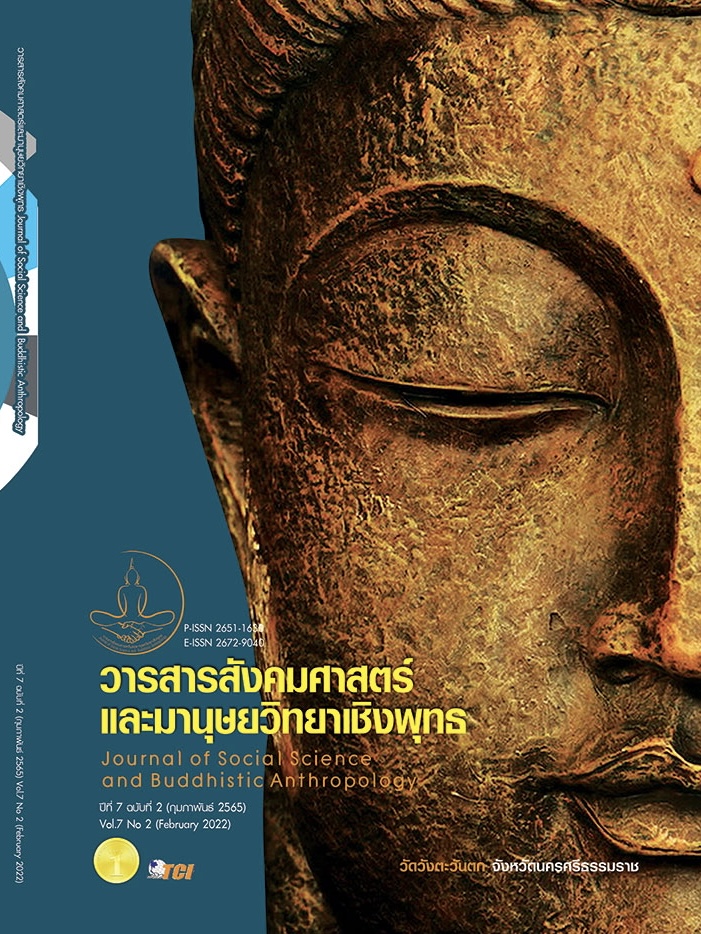THE PROFESSIONAL LEARNING COMMUNITY MODEL FOR ACTIVE LEARNING DEVELOPMENT OF CHOPMPHRAPRACHASAN SCHOOL, THE SECONDARY EDUCATIONAL SERVICE AREA OFFICE 33
Keywords:
The PLC Model, Active learning, Active learning performanceAbstract
The objective of this research were to study the PLC model components, to create the PLC model, to implement the PLC model and to evaluate the Professional Learning Community Model for Active Learning Development of Chomphraprachasan School, The Secondary Educational Service Area Office 33 by research and development methodology 4 stages; 1) studying the PLC model components by literature reviewing and interview with 10 experts. 2) Creating the PLC model by drafting the model and the models’ suitable assessment by 9 the academic experts. 3) Implementing the PLC model in 2562 school year by 122 teachers. 4) Evaluating the PLC model. The data was collected from 122 teachers. The research tools were interview form, checking form, questionnaires. The statistics used for data analysis were mean standard deviation, content analysis and summary. The finding showed as follow; the Professional Learning Community components consist of 8 factors; shared values and vision, collective focus on student learning, collaboration, expert advice and study visit, reflective dialogue, supportive conditions, supportive and shared leadership and caring community. The PlC model consist of 6 factors; (a) Principle, (b) Objectives, (c) PLCs’ elements (d) Learning process (e) Measurement and evaluation and (f) Successfully conditions that the PLC model’s suitable in overall was the highest level. The implement results of the PLC model showed the quality of the active learning plan, teacher active learning performance and student work pieces in overall was the highest level. And the PLC model evaluation in accuracy standards, utility standards, propriety standards, and feasibility standards were the highest level ( = 4.79, S.D. = 0.15).
References
เข็มทอง ศิริแสงเลิศ. (2561). การพัฒนาองค์การแห่งการเรียนรู้ในศตวรรษที่ 21. ใน ประมวลสาระชุดวิชา นวัตกรรมการบริหารการศึกษาและภาวะผู้นำ หน่วยที่ 1-7. นนทบุรี: โรงพิมพ์มหาวิทยาลัยสุโขทัยธรรมธิราช.
ชูชาติ พ่วงสมจิตร์. (2560). ชุมชนการเรียนรู้ทางวิชาชีพ และแนวทางการนำมาใช้ในสถานศึกษา. วารสารศึกษาศาสตร์ มสธ, 10 (1): 34-41.
ฐาปณัฐ อุดมศรี. (2558). รูปแบบการบริหารโรงเรียนเพื่อเสริมสร้างชุมชนแห่งการเรียนรู้ทางวิชาชีพด้านการวิจัยปฏิบัติการในชั้นเรียน. ใน ดุษฎีนิพนธ์ครุศาสตรดุษฎีบัณฑิต สาขาวิชาบริหารการศึกษา. จุฬาลงกรณ์มหาวิทยาลัย.
ณิรดา เวชญาลักษณ์. (2561). หลักการจัดการเรียนรู้. กรุงเทพมหานคร: โรงพิมพ์แห่งจุฬาลงกรณ์มหาวิทยาลัย.
ทิศนา แขมมณี. (2556). รูปแบบการเรียนการสอน : ทางเลือกที่หลากหลาย. กรุงเทพมหานคร: จุฬาลงกรณ์มหาวิทยาลัย.
บุญเลี้ยง ทุมทอง. (2559). ทฤษฎีและการพัฒนารูปแบบการจัดการเรียนรู้. (พิมพ์ครั้งที่ 3). กรุงเทพมหานคร: ทริปเพิ้ล เอ็ดดูเคชั่น.
ปรณัฐ กิจรุ่งเรือง และอรพิณ ศิริสัมพันธ์. (2561). ชุมชนแห่งการเรียนรู้เชิงวิชาชีพครู: กลยุทธ์การยกระดับคุณภาพการศึกษา: แนวคิดสู่การปฏิบัติ. นนทบุรี: M & N Design.
ประภาภาณ์ คำโอภาส. (2560). รูปแบบชุมชนการเรียนรู้ทางวิชาชีพของครูศูนย์การศึกษานอกระบบและการศึกษาตามอัธยาศัยในเขตภาคเหนือตอนบน. ใน ดุษฎีนิพนธ์ปรัชญาดุษฎีบัณฑิต สาขาวิชาบริหารการศึกษา. มหาวิทยาลัยเชียงใหม่.
ปรีชาญ เดชศรี. (2545). การเรียนรูปแบบ Active Learning: ทำได้อย่างไร. วารสาร สสวท, 30(116), 53-55.
พิมพันธ์ เดชะคุปต์ และพเยาว์ ยินดีสุข. (2561). การเรียนรู้เชิงรุกแบบรวมพลังกับ PLC เพื่อการพัฒนา. กรุงเทพมหานคร: โรงพิมพ์แห่งจุฬาลงกรณ์มหาวิทยาลัย.
มินตรา ลายสนิทเสรีกุล, และปิยพงษ์ สุเมตติกุล. (2557). กลยุทธ์การบริหารโรงเรียนสู่การเป็นชุมชนแห่งการเรียนรู้วิชาชีพของโรงเรียนมัธยมศึกษาในสหวิทยาเขตเบญจบูรพากรุงเทพมหานคร. วารสาร OJED, 9(3), 392-406.
โรงเรียนจอมพระประชาสรรค์. (2561). ผลการประเมินตนเองของสถานศึกษา ปีการศึกษา 2561. สุรินทร์: โรงเรียนจอมพระประชาสรรค์.
โรงเรียนจอมพระประชาสรรค์ .(2562). ผลการประเมินคุณภาพภายนอกรอบสาม ระดับการศึกษาขั้นพื้นฐานโรงเรียนจอมพระประชาสรรค์. สุรินทร์: โรงเรียนจอมพระประชาสรรค์.
วัชรา เล่าเรียนดี และคณะ. (2560). กลยุทธ์การจัดการเรียนรู้เชิงรุก เพื่อพัฒนาการคิดและยกระดับคุณภาพการศึกษา สำหรับศตวรรษที่ 21. นครปฐม: เพชรเกษม พริ้นติ้ง กรุ๊ป.
วัชรี เกษพิชัยณรงค์ และคณะ. (2555). การเรียนเชิงรุกและเทคนิควิธีการจัดการเรียนการสอนที่เน้นการเรียนเชิงรุก. กรุงเทพมหานคร: สถาบันนวัตกรรมการเรียนรู้ มหาวิทยาลัยมหิดล.
สำนักงานคณะกรรมการการศึกษาขั้นพื้นฐาน. (2561). การประเมินตนเองและจัดทำแผนพัฒนาตนเองรายบุคคล (Individual Development Plan : ID PLAN). กรุงเทพมหานคร: สำนักงานคณะกรรมการการศึกษาขั้นพื้นฐาน.
สำนักงานเลขาธิการสภาการศึกษา. (2552). กรอบการปฏิรูปการศึกษาในทศวรรษที่สอง (พ.ศ. 2552-2561). กรุงเทพมหานคร: สกศ.
Arends, R. I. (1997). Classroom Instruction and Management. New York: McGraw Hill.
Bonwell, C.C, & Eison, J.A. (1991). Active learning: Creative Excitement in the Classroom. ASHE-ERIC Higher Education ReportGeorge Washington University. Washington DC: School of Education and Human Development.
Brookfield, S. (1995). Becoming a Critically Reflective Teacher. New York: Wiley.
Darling-Hammond, L. (1999). Teacher quality and student achievement. Washington: Centre for the study of teaching and policy, university of Washington.
Hallam, P.R., et al. (2015). Trust and Collaboration in PLC Teams: Teacher Relationships, Principal Support, and Collaborative Benefits. NASSP Bulletin, 99(3) (Sep.) ; 193-216.
Hargreaves, A. (2003). Teaching in the knowledge society: Education in the age of insecurity. New York: Teacher College Press.
Joyce, B. & Weil, M. (2000). Model of Teaching. (6th Edition). Boston : Allyn and Bacon.
Marlowe, B. A., & Page, M. L. (2005). Creating and Sustaining the Constructivist Classroom. (2nd ed.). California: Corwin Press.
Meyer, C. & Jones, T.B. (1993). Promoting Acting Learning, Strategies for the College Classroom. San Francisco: Jossey-Bass.
Saylor, J. G. et al. (1981). Curriculum Planning for Better Teaching and Learning. (4th Edition). New York: Holt, Rinehart and Winston.
Stoll, M. et. al. (2003). Professional Learning Community. New York: Open University Press.
Downloads
Published
How to Cite
Issue
Section
License
Copyright (c) 2022 Journal of Social Science and Buddhistic Anthropology

This work is licensed under a Creative Commons Attribution-NonCommercial-NoDerivatives 4.0 International License.








